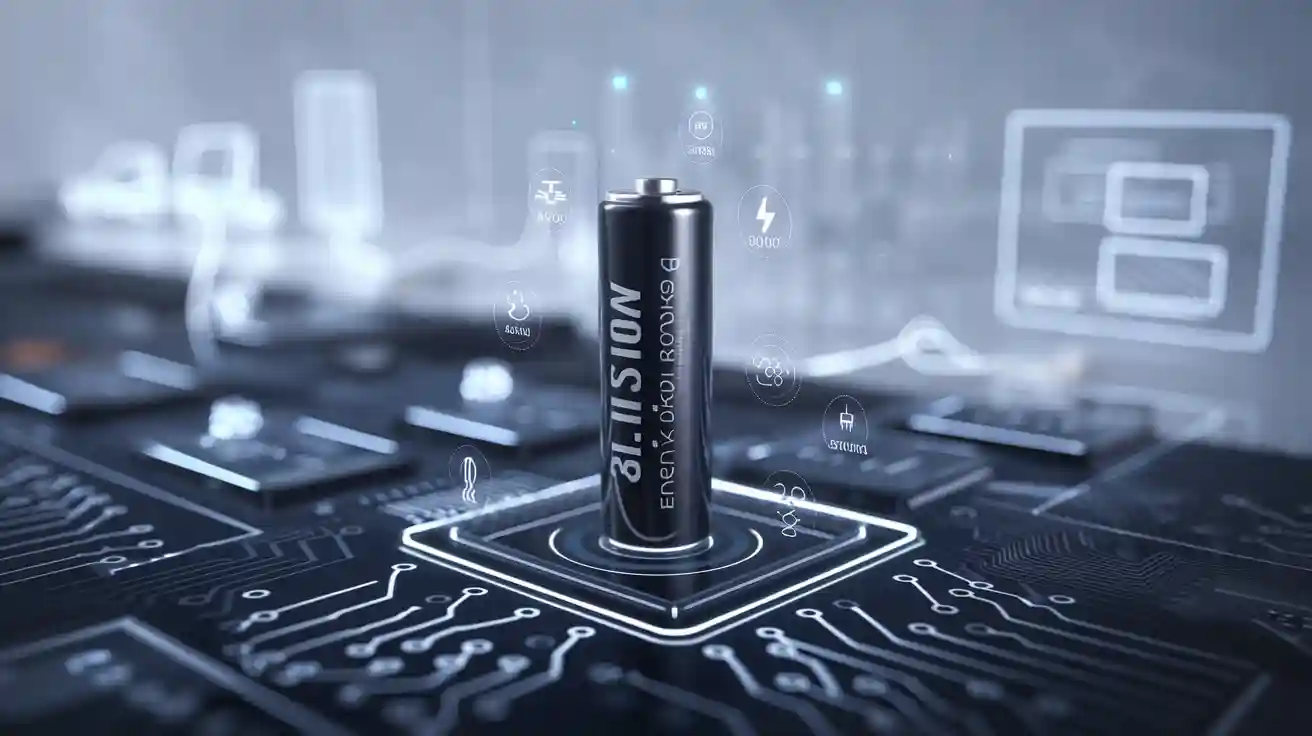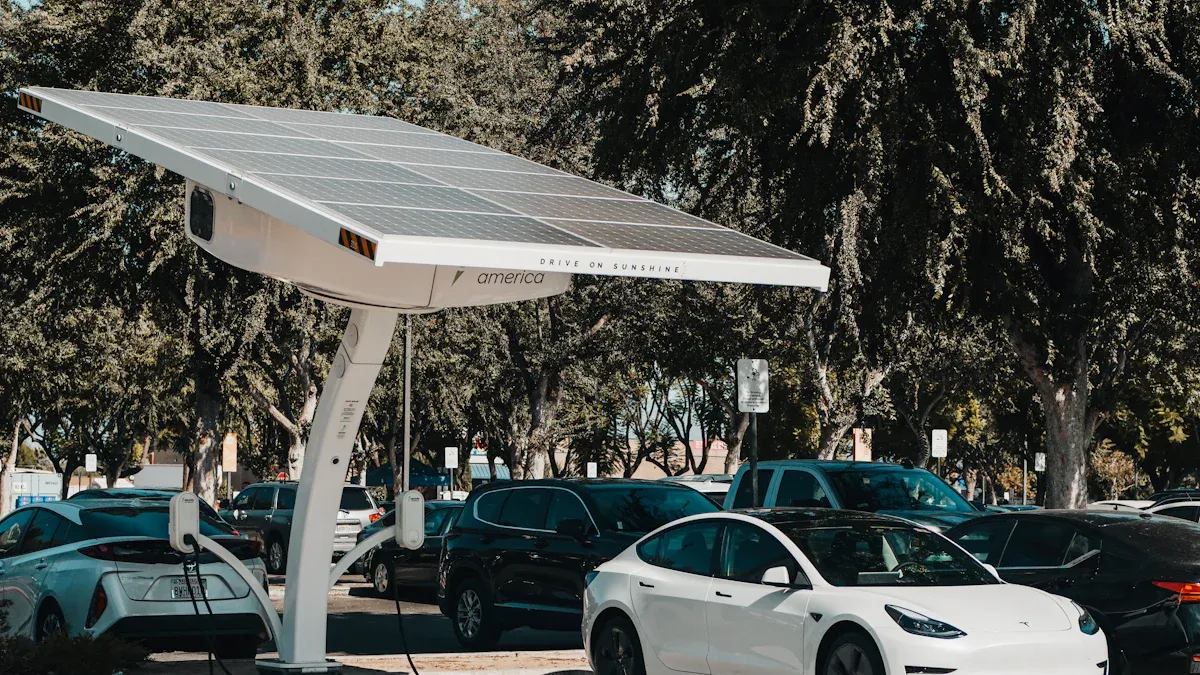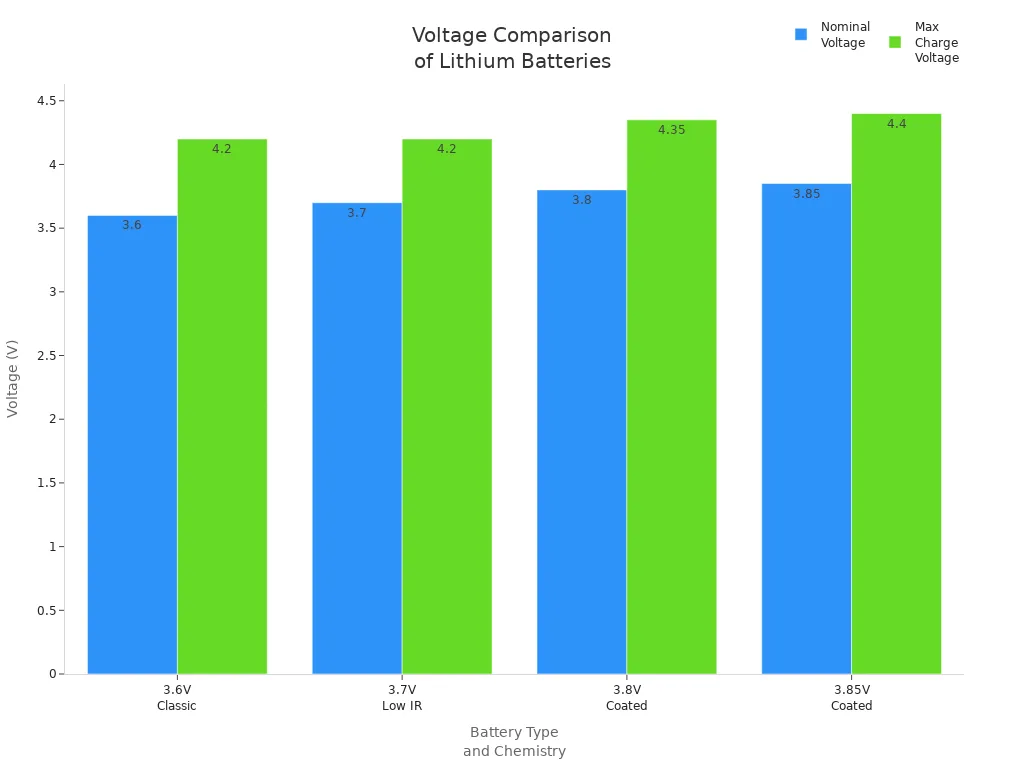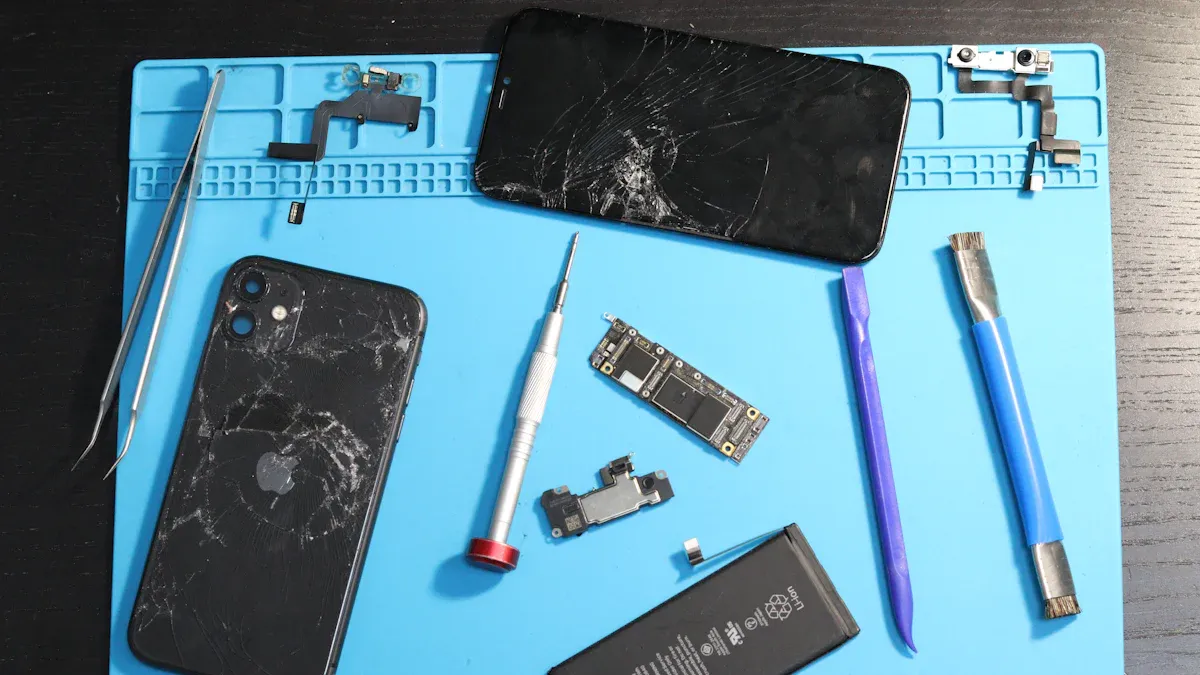
В новых смартфонах и носимых устройствах часто встречаются литий-ионные аккумуляторы с напряжением 3,8 В. Вы можете задаться вопросом, почему они пришли на смену более старым литиевым батареям 3,7 или даже 3,6 В. Ответ кроется в их более высоком напряжении и повышенной плотности энергии. Такие батареи дольше служат в вашем устройстве, прежде чем им потребуется подзарядка. Большинству современных гаджетов требуется больше энергии в небольших пространствах, поэтому литий-ионные батареи 3,8 В подходят лучше, чем литиевые батареи 3,7 В или 3,6 В. Производители устройств выбирают подходящий аккумулятор в соответствии с дизайном и потребностями в энергии.
Литий-ионные аккумуляторы 3,8 В в сравнении с литиевыми аккумуляторами 3,7 В

Напряжение и химия
Вы можете заметить, что литий-ионные аккумуляторы 3,8 В и литиевые аккумуляторы 3,7 В выглядят одинаково, но их отличает напряжение и химический состав. В литий-ионных аккумуляторах 3,8 В используются специальные покрытия и добавки внутри элементов. Эти изменения позволяют батарее достигать более высокого напряжения. Номинальное напряжение литий-ионного аккумулятора 3,8 В составляет 3,8 В, в то время как номинальное напряжение литиевого аккумулятора 3,7 В составляет 3,7 В. Классический литиевый аккумулятор 3,6 В имеет номинальное напряжение 3,6 В.
Максимальное напряжение заряда также различается. Литий-ионный аккумулятор 3,8 В может заряжаться до 4,35 В. В отличие от этого, литиевые батареи 3,7 и 3,6 В обычно заряжаются до 4,2 вольт. Это более высокое напряжение означает, что литий-ионные аккумуляторы 3,8 В могут хранить больше энергии на той же площади.
Совет: Всегда проверяйте, поддерживает ли ваше устройство более высокое напряжение, прежде чем использовать литий-ионный аккумулятор 3,8 В. Использование неправильного аккумулятора может повредить ваше устройство или сократить срок его службы.
Вот график, который показывает разница в напряжении между этими батареями:

Химический состав внутри элементов также влияет на работу аккумулятора. В литий-ионных аккумуляторах 3,8 В используются передовые материалы, которые обеспечивают более высокое напряжение и лучшую производительность. В литиевых батареях 3,7 и 3,6 В используются более старые химические материалы, что означает, что они не могут достичь такого же напряжения или накопления энергии.
Плотность и мощность энергии
Если сравнить плотность энергии, то можно увидеть явное преимущество литий-ионных аккумуляторов 3,8 В. Последние технические данные показывают, что эти батареи обеспечивают около 15% больше плотности энергии чем литиевая батарея 3,7 В того же размера. Это означает, что вы получаете более длительное время автономной работы и больше энергии для ваших устройств без увеличения размера батареи.
Сайт В таблице ниже показано сравнение различных аккумуляторов по напряжению и мощности:
| Тип батареи Описание | Номинальное напряжение | Максимальное напряжение заряда | Указания по вместимости и использованию |
|---|---|---|---|
| Классические литий-ионные (LCO) на основе кобальта | 3.6V | 4.2V | Стандартное номинальное напряжение, типичная емкость |
| Тернарный литий | 3.7V | 4.2V | Низкое внутреннее сопротивление, стандартная емкость |
| Улучшенное покрытие поверхности/добавки | 3.8V | 4.35V | Требуется правильное напряжение зарядного устройства, более высокая энергия |
| Дополнительные улучшенные добавки | 3.85V | 4.4V | Обеспечивает более высокую продолжительность работы, но меньший срок службы |
Благодаря более высокому напряжению и улучшенному химическому составу литий-ионные аккумуляторы 3,8 В обеспечивают больше энергии и более длительное время работы. Однако для таких батарей необходимо зарядное устройство, соответствующее их более высокому напряжению. Если вы используете зарядное устройство, предназначенное для литиевой батареи 3,7 или 3,6 В, вы не сможете получить полную емкость от литий-ионной батареи 3,8 В.
Более высокое напряжение и плотность энергии делают литий-ионные аккумуляторы 3,8 В отличным выбором для небольших устройств, таких как смартфоны, носимые устройства и IoT-гаджеты. Этим устройствам нужны батареи, которые помещаются в тесном пространстве, но при этом служат долго. Элементы в литий-ионных аккумуляторах 3,8 В помогают удовлетворить эти потребности.
Примечание: Устройства должны поддерживать более высокое напряжение и конкретный размер литий-ионных аккумуляторов 3,8 В. Перед заменой или обновлением аккумулятора всегда сверяйтесь с инструкцией к устройству.
Почему стоит выбрать 3,8 В?
Преимущества
Вы можете удивиться, почему так много новых устройств используют Литий-ионные аккумуляторы 3,8 В. Эти батареи обладают рядом важных преимуществ:
- Вы получаете больше энергии из батареи того же размера. Более высокое напряжение и улучшенная плотность энергии означают, что вы можете использовать батареи меньшего размера без потери мощности.
- Маленькие и легкие аккумуляторы помогают дизайнерам создавать более тонкие и легкие продукты. Планшеты, носимые устройства и беспроводные микрофоны теперь помещаются в более тонкие корпуса благодаря таким батареям.
- Некоторые аккумуляторы 3,8 В выпускаются в виде тонкой пленки или изогнутой формы. Это позволяет компаниям создавать устройства с уникальным и компактным дизайном.
- Элементы этих аккумуляторов обеспечивают стабильное напряжение и эффективную мощность. Ваше устройство работает дольше и лучше между зарядками.
- Вы заметите, как увеличивается время автономной работы вашего телефона или часов. Большая емкость означает, что вы тратите меньше времени на зарядку и больше на использование устройства.
Совет: Если вам нужно устройство, которое проработает весь день и будет легко лежать в руке, ищите его с аккумулятором 3,8 В.
Недостатки
Хотя батареи 3,8 В имеют множество преимуществ, вы должны знать и об их недостатках:
- Эти батареи часто стоят дороже старых типов. Усовершенствованные элементы и материалы повышают цену.
- Не все устройства поддерживают более высокое напряжение. Если вы используете неправильный аккумулятор, вы можете повредить устройство или сократить срок его службы.
- Срок службы некоторых аккумуляторов 3,8 В может сократиться, если каждый раз заряжать их до максимального напряжения. При высокой нагрузке элементы могут быстрее изнашиваться.
- Необходимо использовать правильное зарядное устройство. Зарядка с неправильным напряжением может снизить емкость аккумулятора и сократить срок его службы.
- Совместимость может быть проблемой. Перед переходом на новый тип аккумулятора всегда сверяйтесь с инструкцией к своему устройству.
Примечание: Уход за батареей и следование рекомендациям производителя помогут вам получить максимальный срок службы элементов.
Литий-ионные аккумуляторы 3,8 В: Применение

Мобильные устройства и носимые устройства
Литий-ионные аккумуляторы 3,8 В можно увидеть во многих устройствах, которыми вы пользуетесь каждый день. Эти батареи питают некоторые из самых современных гаджетов на рынке. Вот некоторые распространенные устройства, в которых можно встретить эти батареи:
- Высококачественные смартфоны
- Настоящие беспроводные наушники (TWS)
- Ноутбуки
- Носимые устройства, такие как смарт-часы и фитнес-трекеры
- Медицинские приборы, нуждающиеся в надежном питании
- IoT-устройства для умных домов и промышленности
- Робототехника для домашнего и профессионального использования
- Профессиональные дроны
Вы заметили, что эти аккумуляторы помогают сделать устройства легче и работают дольше. Когда вы пользуетесь смарт-часами или беспроводными наушниками, вы хотите, чтобы они работали весь день без подзарядки. Аккумулятор 3,8 В дает дополнительную энергию. В медицинских устройствах стабильная батарея обеспечивает безопасную работу оборудования. Робототехнике и беспилотникам также нужна батарея, обеспечивающая стабильное питание для длительных полетов или выполнения задач.
Совет: Если вам нужно тонкое и мощное устройство, проверьте, используется ли в нем аккумулятор 3,8 В.
Тенденции развития отрасли
Рынок портативной электроники быстро меняется. Сейчас литий-ионные аккумуляторы 3,7 В по-прежнему занимают наибольшую долю, особенно в смартфонах, планшетах и ноутбуках. Однако сегмент батарей 3,8 В растет. Все больше промышленных и медицинских устройств используют эти батареи, поскольку им требуется более высокая плотность энергии и более длительное время работы.
Спрос на компактные и легкие аккумуляторы продолжает расти. Носимые технологии и другие портативные устройства заставляют компании улучшать характеристики батарей. Вы получаете преимущества благодаря усовершенствованиям в области плотности энергии, срока службы и безопасности. Благодаря этим улучшениям аккумуляторы 3,8 В становятся все более популярными в новых продуктах.
Ожидается, что рынок литиевых батарей штыревого типа будет расти темпами 7.3% ежегодно до 2032 года. Большую часть этого роста обеспечивает бытовая электроника. Азиатско-Тихоокеанский регион лидирует, поскольку все больше людей покупают электронику и электромобили. Компании инвестируют в исследования и разработки, чтобы сделать аккумуляторы лучше и доступнее. Благодаря этому устройства служат дольше и заряжаются быстрее.
Примечание: По мере развития технологий вы увидите еще больше устройств, использующих аккумуляторы 3,8 В для повышения производительности и увеличения срока службы.
Выбор правильного аккумулятора
Соображения производителя
Когда вы разрабатываете или выбираете аккумулятор для нового устройства, необходимо обратить внимание не только на напряжение. Необходимо проверить, соответствует ли батарея строгим стандартам безопасности и качества. В Соединенных Штатах, Сертификация UL2054 проверяет литий-полимерные батареи на электрическую и механическую безопасность. В том числе проверьте, как батарея переносит перезаряд, прокол и удар. Аккумулятор должен иметь прочный корпус, чтобы предотвратить возгорание или травмы. В Европе для портативных элементов необходима маркировка CE и сертификат IEC 62133. Для транспортировки требуется сертификат UN38.3, подтверждающий, что батарея безопасна для перевозки. В Японии и Южной Корее действуют свои правила, например, сертификация PSE и KC.
Кроме того, вы столкнетесь с высокими затратами и длительным временем тестирования. Например, Сертификация UL 1642 может стоить до $20,000 и занимает несколько месяцев. Около 30% батарей не проходят первый раунд тестирования по стандарту UN38.3. Вы должны использовать сертифицированных поставщиков элементов и хранить всю техническую документацию, такую как MSDS и схемы защиты. Эти шаги помогут вам избежать задержек и обеспечат выход вашей батареи на мировые рынки.
| Сертификация | Регион | Назначение |
|---|---|---|
| UL2054/1642 | США | Безопасность клеток и упаковок |
| IEC 62133 | Глобальный/ЕС | Безопасность переносных камер |
| UN38.3 | Глобальная | Безопасная транспортировка |
| CE | ЕС | Здоровье, безопасность, окружающая среда |
| PSE/KC | Япония/Корея | Электробезопасность |
Советы потребителям
При выборе или замене аккумулятора необходимо подобрать тип аккумулятора к вашему устройству. Всегда проверяйте, поддерживает ли ваше устройство батарею 3,8 В, нужна ли ему литиевая батарея 3,7 В или литиевая батарея 3,6 В. Использование неправильного аккумулятора может повредить устройство или сократить срок его службы. Также следует обратить внимание на элементы внутри батареи. Качественные элементы служат дольше и работают лучше.
Совет: Используйте только зарядные устройства, одобренные производителем. Зарядные устройства, не одобренные производителем, могут привести к перезарядке элементов и перегреву.
При обращении с батареями и их замене необходимо соблюдать следующие правила безопасности:
- Следите за признаки неисправности батареи, такие как вздутие, нагрев или низкая производительность. Замените батарею, если вы заметили эти признаки.
- Храните батареи в сухом прохладном месте при заряде около 50%. Держите их вдали от металлических предметов во избежание короткого замыкания.
- Обращайтесь с батареями осторожно. Не роняйте, не прокалывайте и не раздавливайте их.
- Перерабатывайте старые батарейки в специальных центрах. Никогда не выбрасывайте их в мусор.
- Если вы видите дым, вздутие или огонь, покиньте помещение и вызовите помощь. Используйте огнетушитель класса D или песок, а не воду.
Следуя этим указаниям, вы обеспечите наилучшую производительность и безопасность. Перед заменой батареи всегда читайте руководство по эксплуатации устройства. Это поможет вам избежать проблем и продлит работу устройства.
Литий-ионный аккумулятор 3,8 В часто выбирают, когда требуется большая мощность и длительное время работы. Эти батареи лучше всего работают в высокопроизводительных системах, таких как электромобили, промышленное оборудование и системы хранения энергии.
- Вы видите Сегмент аккумуляторов 3,8-4,0 В быстро растет потому что эти батареи обеспечивают более высокое напряжение и долговечность.
- Батареи 3,7 В по-прежнему доминируют в большинстве потребительской электроники, но спрос на передовые аккумуляторные технологии продолжает расти.
И производители, и потребители выигрывают от повышения плотности энергии и безопасности. Новые материалы, такие как кремниевые аноды и твердотельные электролиты обещают еще более высокую производительность батарей в ближайшие пять лет.
Технология производства аккумуляторов будет развиваться и дальше, создавая более безопасные, долговечные и мощные устройства.
ЧАСТО ЗАДАВАЕМЫЕ ВОПРОСЫ
Чем отличается литий-ионный аккумулятор 3,8 В от литиевого аккумулятора 3,7 В?
При том же размере вы получаете более высокое напряжение и больше энергии. В литий-ионном аккумуляторе 3,8 В используются передовые материалы. Это позволяет устройству работать дольше, прежде чем потребуется подзарядка.
Можно ли использовать литий-ионный аккумулятор 3,8 В в любом устройстве?
Обязательно ознакомьтесь с инструкцией к вашему устройству. Некоторые устройства работают только с определенным напряжением батареи. Использование неправильного аккумулятора может повредить устройство или сделать его небезопасным.
Как безопасно хранить литий-ионный аккумулятор 3,8 В?
- Храните батарею в сухом прохладном месте.
- Храните его заряженным примерно наполовину.
- Избегайте металлических предметов вблизи батареи.
- Перерабатывайте старые батарейки в проверенных центрах.
Как долго служит литий-ионный аккумулятор 3,8 В?
Большинство литий-ионных аккумуляторов 3,8 В служат от 2 до 3 лет при нормальном использовании. Срок службы может сократиться, если вы каждый раз заряжаете его до полного заряда или используете в жарких помещениях.

